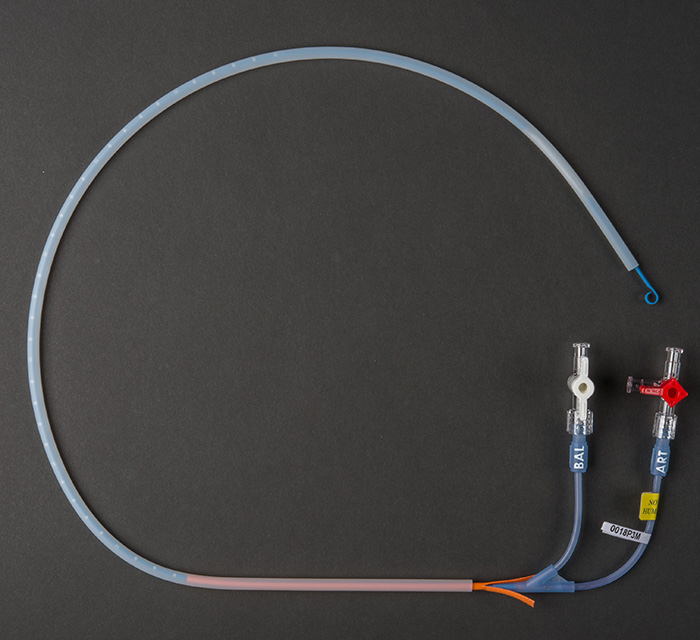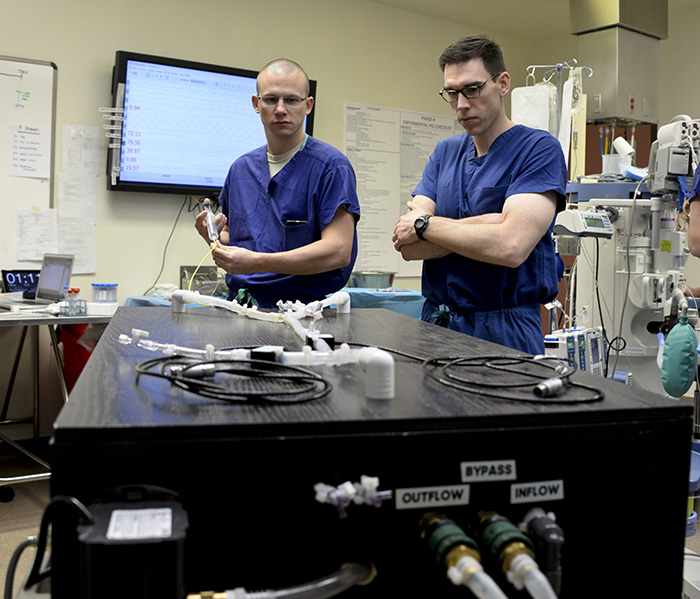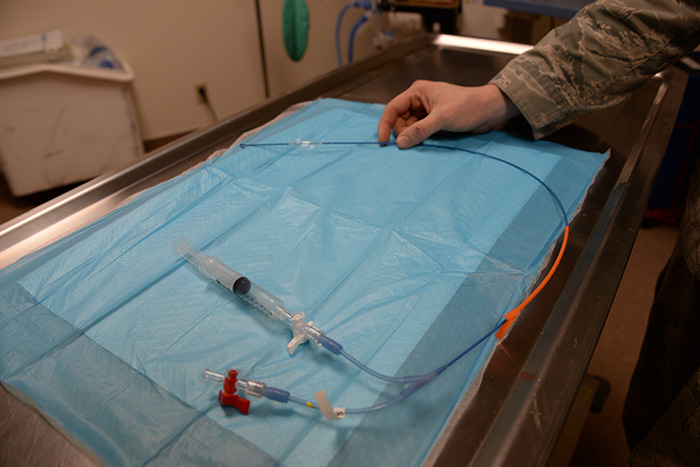State-of-the-Art Balloon Catheter Saves Lives on the Battlefield
Device Added to Military Medical Museum Collection
By Lauren Bigge
NMHM Public Affairs Coordinator
During the episode "The Fog of War" of the CBS drama series Code Black, two characters quickly decided to use a "balloon-tipped catheter" for "REBOA" to save a patient. The concept: a balloon that temporarily stops major bleeding in the aorta of the heart. It's a device that can save lives and it's a story that started with the American military. The U.S. Army Medical Research and Materiel Command's Combat Casualty Care Research Program (CCCRP) and Code Black's head writer-executive producer were even in touch about the episode's accuracy, which turned into a mutually-beneficial partnership.
Military service members developed the small balloon-tipped catheter into its current state-of-the-art form due to the need for a piece of equipment that could be used in a battlefield environment to rapidly slow internal bleeding, without damaging vital organs, long enough for a patient to receive life-saving care. The ER-REBOA is used for the procedure called "Resuscitative Endovascular Balloon Occlusion of the Aorta," to stop hemorrhaging that cannot otherwise be stopped using either conventional or junctional tourniquets.
"This works for a class of wounds you can't put a tourniquet on," said Alan Hawk, who manages the Historical Collections at the National Museum of Health and Medicine. NMHM is the Department of Defense's military medical museum and is an element of the Defense Health Agency. "If you're in a situation in the field and you couldn't clamp the artery, this would let you do it. It's the sort of innovation unique to military medicine that will save lives on the battlefield and, possibly, become a common practice elsewhere."
Col. Todd Rasmussen, a vascular surgeon, former CCCRP Director and current Associate Dean for Research at the Uniformed Services University, told the NMHM's May 2016 Medical Museum Science Café program audience that while the origins of a balloon aortic occlusion device were reported during the Korean War in the 1950s, emergency endovascular capabilities were nonexistent in 2003 and 2004 at the beginning of the Iraq and Afghanistan wars. Rasmussen deployed to Balad Air Base, Iraq, in 2004 during Operation Iraqi Freedom, where he learned from caring for the wounded at Balad's Air Force Theater Hospital that medical personnel needed to be able to control a non-compressible hemorrhage and assess the effect of a blocked aorta.
"We've known hemorrhage has been a cause of death for a long time," Rasmussen said. "We wanted to be able to place this [balloon catheter] without an X-ray, make sure it didn't need an additional wire, and be able to have it as an arterial line. This is placed through a small puncture in the femoral artery, instead of a big incision. In that way, it might be used by medics outside of a hospital."
Following Rasmussen's Science Café presentation, and after meeting a representative from the ER-REBOA manufacturer Prytime Medical Devices, Inc. at a medical research symposium, Hawk requested an ER-REBOA to add to the museum's collection of artifacts documenting the history of combat casualty care, which includes a variety of tourniquets and clamp technologies. The ER-REBOA was received at NMHM in January 2017.
"This device is a continuation of our collection documenting the history of hemorrhage control," said Hawk. The museum collection includes over 155 artifacts ranging from 19th century tourniquets used for amputations to hemostatic forceps used in surgical procedures. The Department of Defense's pioneering role in controlling blood loss during pre-hospital care is represented by the development of hemostatic bandages and new types of tourniquets first used during the conflicts in Afghanistan and Iraq. Civilian first responders are benefiting from the military's "lessons learned" in the area of bleeding control through the DoD-supported "Stop the Bleed" campaign.
The first pre-hospital ER-REBOA use was by the United Kingdom Air Ambulance Service in June 2014. The Joint Theater Trauma System Clinical Practice Guideline for REBOA was also published in June 2014, approving its use in Afghanistan. The ER-REBOA received Federal Drug Administration approval for sale and distribution in 2015, and select use in both military and civilian medical facilities in the United States began in January 2016.
And it works: Air Force surgeon Joseph DuBose used ER-REBOA at the University of California Davis Medical Center to save a trauma victim's life in February 2016.
"ER-REBOA stabilizes the patient for a short period of time," Rasmussen said during his NMHM presentation. "It allows the patient to survive in time for an operation."
According to the CCCRP, ER-REBOA tools are currently being used domestically mostly by personnel at the R Adams Cowley Shock Trauma Center at the University of Maryland Medical Center in Baltimore, as well as by U.S. warfighters in theater worldwide.
The museum is working on incorporating the artifact and its story into an exhibit on advances in military medicine.
Seeing modern military technologies, especially life-saving equipment such as ER-REBOA and tools used by critical care air transport teams, which help to save more injured service personnel than ever, makes an impression on museum visitors.
"The museum has been collecting state-of-the art, contemporary military medical technology for 155 years," Hawk said. "Continuing that effort with ER-REBOA keeps the museum's collections relevant and useful for many years to come."
Click any photo to view larger version

|
Caption:
ER-REBOA (Resuscitative Endovascular Balloon Occlusion of the Aorta) Catheter is used to stop internal hemorrhage that cannot be stopped using either conventional or junctional tourniquets. (20017.0002.1) (National Museum of Health and Medicine photo by Matthew Breitbart / Released) |

|
Caption:
Maj. Timothy Williams, left, and Maj. Lucas Neff, right, perform bench top testing of balloon catheters March 14 at Travis Air Force Base, Calif., using a custom-made blood flow simulator. The CIF, located at David Grant USAF Medical Center, is the research facility where the REBOA catheter came to fruition. (U.S. Air Force photo by Senior Airman Amber Carter) (VIRIN 160314-F-OT558-109) (http://dvidshub.net/r/obf6yi) |

|
Caption:
The REBOA catheter is a device that is inserted into a hemorrhaging vessel and stops or slows the blood flow to that injury while allowing blood flow to continue to vital organs and body parts. (U.S. Air Force photo by Senior Airman Amber Carter) (VIRIN: 160309-F-OT558-018) (http://dvidshub.net/r/4mf6lf) |



